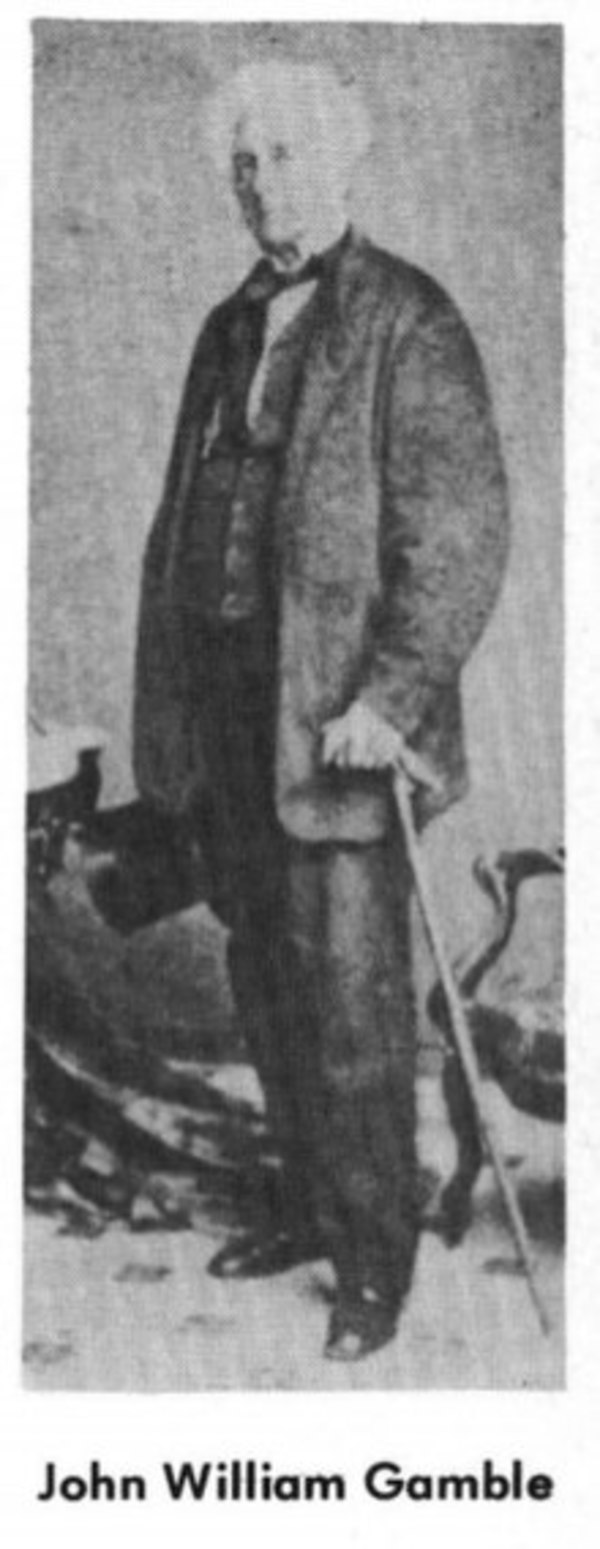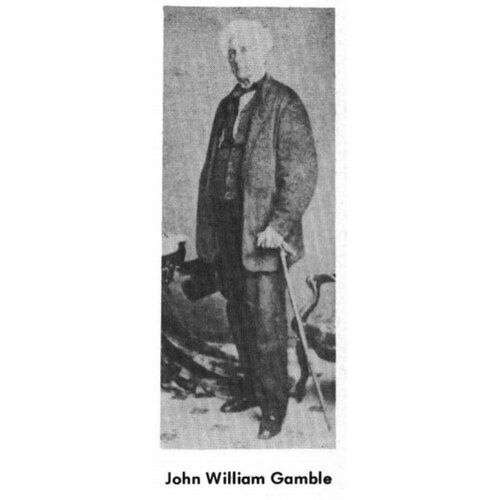
Source: Courtesy of Wikimedia Commons
GAMBLE, JOHN WILLIAM, manufacturer and politician; b. 5 July 1799, in the garrison at York (Toronto), U.C., eldest son of John Gamble, loyalist and army surgeon, and Isabella Elizabeth Clarke of Connecticut; m., in 1822, Mary, daughter of James Macaulay* of York, by whom he had five children; in 1834, Matilda Atkinson, by whom he had three daughters; and thirdly the widowed Minerva Anne Niles; d. 12 Dec. 1873 at Pine Grove, Ont.
John William Gamble was brought up in Kingston but returned to York about 1815 because the family lands were concentrated in Etobicoke Township. He kept a store, first with his brother-in-law William Allan* and, from about 1822, with his own brother, William*, to whom he left most of the responsibility until the arrangement was dissolved in William’s favour in 1827. By 1823 J. W. Gamble had settled on Mimico Creek in Etobicoke to engage in farming, milling, and management of his inheritance. He became a magistrate in 1827 and was chairman of General Quarter Sessions of the Home District from 1836 to 1842. In the absence of Church of England clergymen he read services in Mimico (now in the borough of Etobicoke) until Christ Church was built on land he gave in 1833.
In 1843 Gamble moved up the Humber to Pine Grove in Vaughan Township. Here he resided the rest of his life and built up a manufacturing complex: grist and flour mill, sawmill, distillery, and a cloth factory. He served 14 active terms on the district (later county) council as reeve of Vaughan Township from 1846, but, a Tory among Reformers, was only twice warden of York County. He supervised the Vaughan Plank Road Company and was parliamentary spokesman (1853–56) for the farmers, millers, and merchants who formed the Bank of Toronto. Gamble helped establish Christ Church, Woodbridge, on land he gave in 1851, and was an influential layman on the synod of the Church of England.
Gamble entered politics in 1838 when he ran as a “Constitutional” Tory and defeated George Duggan to represent the 1st riding of York in the assembly; his electorate, despite later changes, always included both Mimico and Woodbridge, and his political stronghold was Etobicoke. He opposed the union of the Canadas as threatening to extend Catholic influence, and stood in the election of 1841 for “attachment to the Throne and reverence for the Altar.” The Reformer James Hervey Price* defeated him in the brawling poll, and again in 1847. Though returned comfortably in a swing against the followers of Robert Baldwin* in 1851 and 1854, Gamble was unsuccessful in 1857 against William Pearce Howland*, also prominent in milling and the grain trade. Tory and Orange interests brought him forward for the Legislative Council in October 1860, but he suffered a heavy defeat.
Gamble accepted “absolute Free Trade” in December 1847 but by February 1849 he had made protection his central political concern. The threat he saw to Canadian produce and manufacturing came from Britain which, with its overwhelming economic superiority, would keep Canada a permanent “plantation,” a primitive source of raw materials and a helpless dumping ground for British products. Capital must be built up in Canada behind tariff walls, he felt, and not be allowed to leave the country as profit for British capitalists. Under tariffs the United States had grown rapidly, Gamble believed, and he admired Yankee enterprise which he knew from his early business connections with his mother’s relatives in Boston. The annexation movement later in 1849 was viewed by Gamble as a serious threat to Canadian nationality and the British connection, and he feared it could lead to civil war. He joined the executive of the British American League and held the floor (flanked by Ogle Robert Gowan) during much of its second convention. He made proposals for an elective governor and upper house. A pamphlet of his at this time concluded that “To continue British, Canada must possess a prosperity as great and rapid in its growth as that of its neighbour, and with institutions not less favourable to popular liberty.”
From 1851 to 1857 Gamble fought in the legislature against reciprocity with the United States, and also against undiscriminating tariffs that would penalize American raw materials the province could never itself produce but would not protect it from Britain. He also stood for the clergy reserves and against full-blown separate schools. Nevertheless, he deplored, at this period, those Tories who refused to concede that theirs was an age of democracy. His faith in the basic common sense of the mass of the people came from his work on the county council and his views on education showed a loyalty to the local schools. His advocacy of protection, above all, fitted not only his own interests but his vision of a complex, self-reliant, close-knit Canadian society.
Gamble saw himself the squire of a god-fearing parish, a thriving village, to which his own industries were crucial, and a trusty yeomanry. He looked the squire too, broad and tall with a strikingly handsome head and a decisive manner. By the 1860s, however, Gamble had lost his last election, some of his chief causes had been overthrown or bypassed, and various family enterprises had crumpled in the depression of the late 1850s. He turned to genealogy for solace and compiled Family records. Its epigraph revealed a retreat to hard-shelled Toryism : “My son, fear thou God and the King, and meddle not with them that are given to change.”
J. W. Gamble edited Family records of the Gambles of Toronto (Toronto, 1872), and was the author of Letter on Lord Grey’s despatch of 31st March, 1848, relative to Canadian customs duties (Toronto, 1849); Memoir of Isabella Elizabeth Gamble (Toronto, 1859); Produce tables, showing the value of any quantity of grain, the standard weight of which is sixty pounds to the Winchester bushel (Toronto, 1844); Speech on the commercial policy of the country (Toronto, 1852); To the members of the Yorkville branch of the British American League (n.p., [1850]).
MTCL, Baldwin papers, entries for J. H. Price; Boulton papers, Gamble to G. S. Boulton, 15 April 1853. PAC, MG 24, D16 (Buchanan papers), pp.23129–40. Globe (Toronto), July 1854, December 1857, 3–6 Oct. 1860. Leader (Toronto), July 1854, December 1857, 28 Sept. 1860. Mail (Toronto), 13 Dec. 1873. Patriot (Toronto), 30 Jan. 1838, January 1848, December 1851. Arthur papers (Sanderson). British American League, Minutes of the proceedings of the second convention . . . (Toronto, 1849). J. of Education for Ont., XXVII (1874), 9. Town of York, 1815–1834 (Firth). Christ Church, Woodbridge, Ontario, 1842–1967 (n.p., [1967]). Creighton, Macdonald, young politician. Landmarks of Toronto (Robertson), I, 16; V, 321. Joseph Schull, 100 years of banking in Canada, a history of the Toronto-Dominion Bank (Vancouver, Toronto, Montreal, 1958). Samuel Thompson, Reminiscences of a Canadian pioneer for the last fifty years; an autobiography (Toronto, 1884). H. O. Tremayne, One hundred years old; a sketch of the history of Christ Church, Mimico, 1827–1927 (n.p., [1927]).
Cite This Article
Barrie Dyster, “GAMBLE, JOHN WILLIAM,” in Dictionary of Canadian Biography, vol. 10, University of Toronto/Université Laval, 2003–, accessed December 28, 2025, https://www.biographi.ca/en/bio/gamble_john_william_10E.html.
The citation above shows the format for footnotes and endnotes according to the Chicago manual of style (16th edition). Information to be used in other citation formats:
| Permalink: | https://www.biographi.ca/en/bio/gamble_john_william_10E.html |
| Author of Article: | Barrie Dyster |
| Title of Article: | GAMBLE, JOHN WILLIAM |
| Publication Name: | Dictionary of Canadian Biography, vol. 10 |
| Publisher: | University of Toronto/Université Laval |
| Year of publication: | 1972 |
| Year of revision: | 1972 |
| Access Date: | December 28, 2025 |



